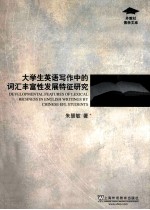

大学生英语写作中的词汇丰富性发展特征研究PDF电子书下载
- 电子书积分:11 积分如何计算积分?
- 作 者:朱慧敏著
- 出 版 社:上海:上海外语教育出版社
- 出版年份:2013
- ISBN:9787544634410
- 页数:264 页
ChapterOne Introduction 1
1.1 Background ofthe Study 1
1.2 Rationale for the Study 5
1.3 Purpose and Method ofthe Study 8
1.4 Significance ofthe Study 10
1.5 Organization ofthe Book 13
Chapter Two Literature Review 16
2.1 Introduction 16
2.2 Definitions of Lexical Richness 17
2.3 Measures for Lexical Richness 20
2.4 Role ofVocabulary in L2 Writing 28
2.5 Developmental Features of Vocabulary in L2 Writing 29
2.6 Lexical Richness in Writings by L1 and L2 Learners 34
2.7 Lexical Richness and L2 Writing Quality 36
2.8 Lexical Features of L2 Writing 40
2.9 Research Gaps and Research Questions 49
2.10 Chapter Summary 52
Chapter Three Methodology 54
3.1 Introduction 54
3.2 Special Considerations for Research Design 55
3.3 Participants 57
3.4 Source of Data 58
3.5 Pilot Study 59
3.6 Procedures for Data Collection 60
3.7 Building the DIY Corpora 65
3.8 Data Analysis 74
3.9 Chapter Summary 84
Chapter Four Results and Findings of the Cross-sectional Study 86
4.1 Introduction 86
4.2 Features of Lexical Variation 86
4.3 Features of Lexical Density 89
4.4 Features of Lexical Sophistication 91
4.5 Features ofWord Length 94
4.6 Features of Word Frequency Distribution 97
4.7 Relationship between Lexical Richness and Overall Writing Performance 101
4.8 Chapter Summary 105
Chapter Five Results and Findings of the Longitudinal Study 106
5.1 Introduction 106
5.2 Features of Lexical Variation 106
5.3 Features of Lexical Density 109
5.4 Features of Lexical Sophistication 110
5.5 Features ofWord Length 112
5.6 Features of Word Frequency Distribution 115
5.7 Relationship between Lexical Richness and 119
Overall Writing Performance 119
5.8 Chapter Summary 122
Chapter Six Resultsand Findingsa cross the Two Corpora 123
6.1 Introduction 123
6.2 Patterns and Discrepancies in Lexical Variation 123
6.3 Patterns and Discrepancies in Lexical Density 126
6.4 Patterns and Discrepancies in Lexical Sophistication 129
6.5 Patterns and Discrepancies in Word Length 132
6.6 Pattems and Discrepanciesin Word Frequency Distribution 134
6.7 Patterns and Discrepancies in the Relationships between Lexical Richness and Overall Writing Performance 140
6.8 Chapter Summary 142
Chapter Seven Results and Findings of the Case Studies 143
7.1 Introduction 143
7.2 Results of KeynessAnalysis 143
7.3 Developmental Features of"we" 147
7.4 Developmental Features of"you" 149
7.5 Developmental Features of"l" 151
7.6 Developmental Features of"can" 152
7.7 Developmental Features of"know" 155
7.8 Developmental Features of"so" 159
7.9 Chapter Summary 165
Chapter Eight Discussion 167
8.1 Introduction 167
8.2 Overuse of High-frequency Words 168
8.3 Vocabulary Plateau Phenomenon in Lexical Variation 170
8.4 Models of Developmental Features of Lexical Richness 173
8.5 Unbalanced Effects of Lexical Richness on the Overall Writing Performance 179
8.6 The Most Overused First and Second Personal Pronouns 181
8.7 The Most Overused Modal Auxiliary 193
8.8 The Most Overused Lexical Word 196
8.9 The Most Overused Multi-function Word 202
8.10 Chapter Summary 205
Chapter Nine Conclusion 206
9.1 Summary ofthe Study 206
9.2 Pedagogical Implications 209
9.3 Limitations ofthe Study 223
9.4 Suggestions for Future Studies 224
9.5 Concluding Remarks 225
References 227
Appendix Ⅰ Prompts of WritingTask 244
Appendix Ⅱ Marking Scheme for TEM-4 and TEM-8 Compositions 245
Appendix Ⅲ Stop List 247
Appendix Ⅳ UCRELCLAWS7Tagset 257
Acknowledgements 263
- 《汉语词汇知识与习得研究》邢红兵主编 2019
- 《法语词汇认知联想记忆法》刘莲编著 2020
- 《《国语》和《战国策》词汇比较研究》陈长书著 2017
- 《剑桥国际英语写作教程 段落写作》(美)吉尔·辛格尔顿(Jill Shingleton)编著 2019
- 《影响葡萄和葡萄酒中酚类特征的因素分析》朱磊 2019
- 《语文阅读与写作教学研究》李玉红,陈晓玲,王芬著 2018
- 《观察、阅读、写作小学作文整体教学与思维训练》马芯兰主编 2016
- 《高中英语词汇考试指导》徐志江编著 2019
- 《新课标初中英语词汇同步速记 八年级 上 通用版》蔡波主编 2018
- 《新课标初中英语词汇同步速记 九年级 全1册》蔡波编 2018
- 《培智学校义务教育实验教科书教师教学用书 生活适应 二年级 上》人民教育出版社,课程教材研究所,特殊教育课程教材研究中心编著 2019
- 《习近平总书记教育重要论述讲义》本书编写组 2020
- 《办好人民满意的教育 全国教育满意度调查报告》(中国)中国教育科学研究院 2019
- 《教育学考研应试宝典》徐影主编 2019
- 《语文教育教学实践探索》陈德收 2018
- 《家庭音乐素养教育》刘畅 2018
- 《学前教育学》王换成主编 2019
- 《近代体育游戏教育史料汇编 第1辑 1》王强主编 2016
- 《全国学前教育专业(新课程标准)“十三五”规划教材 简谱手风琴教程 第2版》(中国)杨克勤,王宝庆 2019
- 《现代教育技术》李志河主编 2019
